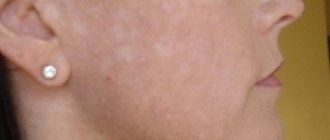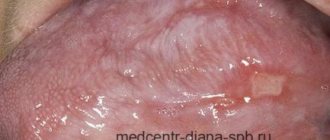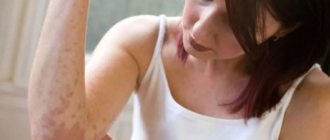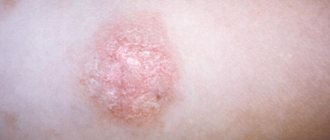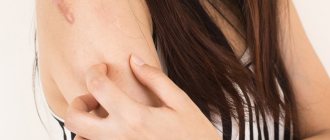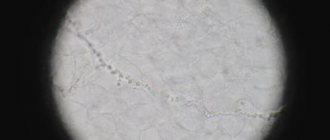1.What is pityriasis versicolor?
Pityriasis versicolor
Also called “lichen versicolor” or “sun fungus”. This type of fungal disease is not as common in our climate as in countries with hot, humid climates. However, dermatologists in Russia detect pityriasis versicolor in 5% of the population.
Especially often, the fungus colonizes on the body of people prone to excessive sweating and seborrheic diathesis, which creates a favorable environment for the introduction and development of this skin infection. Pityriasis versicolor lasts for years without treatment, practically without affecting the general condition of a person, but creating psychological discomfort due to cosmetic defects of the skin. Manifestations of the disease are reduced in winter and worsen in the hot season.
A must read! Help with treatment and hospitalization!
Goodbye beach?
Pityriasis versicolor itself can be successfully treated. The course can last from 2–3 weeks to several months. But sometimes a long-term process with periodic exacerbations is possible. The reason, as a rule, is non-compliance with the prescriptions by the patients themselves. However, sometimes appointments are also lame. Among the common treatment errors is the prescription of quartz procedures. Especially during periods of exacerbation. Then there is no need to discuss with the doctor. It should be changed immediately.
However, the most common reason for prolonged treatment and subsequent exacerbations is non-compliance with prescribed prophylaxis. By the way, it cannot be called tedious. Doctors, for example, recommend using ... medicated anti-dandruff shampoos as a shower gel. And then wipe the skin with diluted lemon juice. In summer, it is enough to repeat this procedure 2-3 times a week. Most importantly, tan lovers need to think about whether it is worth exposing their skin to stress and testing in pursuit of a beautiful movie tan. Although sunbathing after treatment is not prohibited, you still need to do it wisely and without abuse.
2. Causes of the disease
Pityriasis versicolor is caused by the fungi Malassezia furfur and Pityrpsporum orbiculare.
Their habitat is the stratum corneum of the epidermis.
The causative agent of pityriasis versicolor is conditionally pathogenic, that is, it is transmitted from person to person, but does not cause the disease itself in everyone. The likelihood of infection and the onset of the disease increases by a number of factors - external and internal:
- increased sweating and oily skin;
- vegetative-vascular dystonia;
- high blood sugar;
- treatment with corticosteroids;
- decreased immunity;
- hormonal disorders;
- chronic diseases;
- solar radiation;
- hygiene violations;
- stress and metabolic disorders.
It has been noted that the disease affects mainly people of the middle age group. Children under 7 years of age practically do not get pityriasis versicolor.
Visit our Dermatology page
Preventive measures
The following preventive measures will help to avoid the appearance of lichen spots:
- Before visiting a solarium, it is necessary to apply protective cream
- It is necessary to monitor your health and promptly treat various diseases.
- On the beach, you need to lubricate your skin with a special protective product.
- Sunbathing is recommended in the early morning and evening. This will reduce the likelihood of skin damage. The most unfavorable hours are from 11 to 16.
- It is not recommended to wear synthetic underwear.
- You must use only your own towel and observe personal hygiene rules.
- You should not lie on bare sand, and after the beach you should take a shower.
- You need to eat more fruits and vegetables, grains and greens.
Even though the infection does not cause much harm to health, it must be treated. This should be done after consulting a dermatologist so as not to worsen the course of the disease. If solar lichen is diagnosed in time and quality treatment is started, it will go away quickly and easily.
3. Signs and diagnosis of the disease
, asymmetrical spots up to 5 cm in size appear
, which merge over time, forming quite large foci. The edges are usually jagged and the color is yellow, pink, brown or white. Sun exposure often changes the color of the spots. Pityriasis-like peeling occurs on the surface, although inflammatory processes are rare. If papules and pustules appear, then most likely this is a consequence of other skin infections superimposing on the affected areas.
Foci of lichen are usually located on the back, neck, abdomen and shoulders, in the groin area.
If the head is affected, the hair in these places does not change at all. Sometimes pityriasis versicolor causes itchy skin.
It is used to examine foci of affected skin.
Wood's lamp, microscopic analysis, Balser's iodine test.
About our clinic Chistye Prudy metro station Medintercom page!
Symptoms
For a long time, lichen versicolor may not appear at all. Sometimes a person notices its symptoms only in the fall, because the incubation period of the disease lasts 2-3 months.
The spots are white, milky or beige in color, their shade varies from coffee-milky to rich burgundy. They can be of completely different shapes and sizes, their edges are uneven and torn. The lichen does not protrude above the surface of the skin, and there are no signs of inflammation.
When scraping, peeling of the epidermis and, in some cases, mild itching are noted. Over time, the spots merge into large areas, these areas no longer perceive tanning and become especially noticeable.
Why can our articles be trusted?
We make health information clear, accessible and relevant.
- All articles are checked by practicing doctors.
- We take scientific literature and the latest research as a basis.
- We publish detailed articles that answer all questions.
The pathological process is most often localized on the following parts of the body:
- back;
- neck;
- décolleté area;
- shoulders and forearms;
- whiskey;
- Hands;
- stomach.
These are the areas that are highly exposed to sunlight and least protected from ultraviolet rays.
A bacterial infection may accompany lichen versicolor, then the patient will feel pain and itching, and the skin will peel off greatly. Having noticed the first signs of the disease, you need to stop being in the sun and visit a doctor.
4. Treatment of pityriasis versicolor
Treatment of pityriasis versicolor should be carried out in a course. Unsystematic measures only reduce the likelihood of a complete cure. Antimycotics, salicylic alcohol, products with selenium sulfide, and imidazole derivatives have an effective effect on the fungus
rumicosis and terbizil
tablets are prescribed The course of continuous treatment must be
at least 14 days.
In addition to external influences on the fungus - ointments, lotions and sprays - the effectiveness of treatment can increase significantly if the patient himself takes a number of measures:
- exposure to ultraviolet light on the skin;
- wet cleaning and disinfection of living space;
- washing clothes at 90-95 degrees;
- ironing towels and bed linen;
- replacing the washcloth with a new one, updating detergents;
- wearing underwear only made from natural fabrics;
- proper nutrition, adequate sleep, immunostimulating procedures.
During the treatment period and for further prevention of relapse of the disease, folk remedies
, aimed at reducing sweating, cleansing the skin of excess fat, antiseptic measures. Skin fungus does not do well in an acidic environment, so lotions with vinegar, lemon juice and sour berries are suitable.
How to recognize the disease
If you notice symptoms of solar lichen, you should consult a dermatologist. First of all, he examines the skin, finds out whether the patient has recently visited a solarium or whether he has been in direct sunlight for a long time.
The specialist needs to exclude the presence of pathologies such as vitiligo, syphilis, Zhiber's disease, since their symptoms are similar to those of a fungal disease.
The patient must undergo urine and blood tests, and in some cases a stool examination is required. Then the doctor does several tests:
- Laboratory examination of skin scrapings to determine the type of pathogen.
- Examination of skin areas under the light of a fluorescent lamp. If the spot turns yellow-red, blue-green or dark brown, it indicates the presence of sunburn.
- Balzer test by staining spots with iodine solution. The dark areas that appear on the skin are different from healthy areas. This is solar lichen.
The doctor prescribes an ultrasound of the digestive system to identify diseases that are predisposing factors. A proper examination will help you make an accurate diagnosis and prescribe effective treatment.
How to treat solar lichen?
Treatment of solar lichen is a very painstaking matter, it is carried out at home. There are a great variety of drugs, and only a dermatologist can select one or more that are suitable in this particular case.
Unfortunately, there are no universal combinations, but we will look at those medications that, according to real people, help.
Fungicidal preparations
These are fungal killers. They can be systemic (in the form of tablets or capsules) and local.
Fluconazole is used as a systemic drug. It is taken for 2 days, 150 mg. After a week, repeat 300 mg. This is where the treatment ends.
The following antifungal ointments are used to treat solar lichen: Clotrimazole, Nizoral, Lamisil, Exoderil. They are applied 1-2 times a day for a week, then a break is taken for a month, after which the two-week course is repeated.
If you need to treat an area on the head, it is first recommended to wash your hair with an antifungal shampoo (Nizoral, Dermazol, Perhotal, Sebozol), and then apply a fungicidal ointment to it.
Keratolytic drugs
These are products for exfoliating the surface layers of the skin along with the pathogen. These include 2% alcohol solutions of salicylic acid or resorcinol, 50% urea ointment, Arievich ointment. They are applied frequently - every 3 hours.
Such drugs are especially good in the initial stages of the disease. They can also be used together with antiseptic agents with antifungal activity: first, a keratolytic is applied to the lesions of lichen, and then iodine, a solution of fucorcin or Miramistin.
Preparations based on zinc pyrithione
Effective remedies for solar lichen are zinc-based medications: “Psorilom”, “Skin-cap”. The latter is available in the form of a cream (it is applied to the skin of the body) or a spray (it is better to treat the scalp).
Non-drug treatment
During the course of treatment, it is necessary to strengthen hygiene measures:
- take a shower twice a day, and then blot the affected areas with a clean towel (it is washed after each use);
- dress so as not to sweat;
- During treatment, avoid activities that will make you sweat;
- change your underwear daily, after ironing it;
- do not scratch the affected areas.
Prevention
The main efforts should be aimed at preventing the development of solar lichen in humans or preventing frequent exacerbations.
The list of preventive measures is presented by the following points:
- Do not be in direct sunlight during periods of increased sun activity. This applies from 11:00 to 16:00.
- In summer, you should protect your skin with special creams with UV filters.
- Try not to apply tanning products.
- Limit visits to the solarium.
- Use only personal hygiene products - washcloths, towels.
- After each water procedure, the body should be wiped dry.
- Wear clothes and underwear exclusively from natural, “breathable” fabrics (linen, cotton).
- Do not use antibacterial skin care products daily.
- It is advisable to iron washed items with the steam function turned on.
You can slightly reduce the risk of illness in the summer by wiping the skin with warm water that contains a few drops of citric acid.
It is worth remembering that the occurrence of solar lichen is often provoked by other disorders in the body - hyperhidrosis, various endocrine diseases. In this case, re-exacerbation can be avoided only if the main cause of the disease is eliminated.
Features in children
The manifestation of the disease in children is almost entirely similar to the symptoms in adults.
In children, spots most often form on the arms, legs, head and armpits. It is better to treat children's beach lichen only by a dermatologist and avoid using traditional methods, since a child's skin is more delicate and requires a special approach.
Children with reduced immunity are more often exposed to sun fungus, so it is worth paying attention to increasing the child’s body’s defense mechanisms.
Photo of solar lichen
This is what beach lichen looks like during its first manifestations. The spots are small and differ in color from the main skin. Ringworm may appear in early spring or fall. At this stage, the disease practically does not cause any discomfort.
After the first contact with the sun's rays, when a slight tan appears, the affected areas are not pigmented and look lighter than the rest of the skin. Sometimes patients confuse sunburn with sunburn spots.
Ignoring the disease leads to the fact that small spots of different sizes merge and form large areas of white color on tanned skin. At this stage, the patient feels discomfort, since appearing without clothes or with an open back attracts unwanted attention.
The scalp is affected much less frequently than the neck, chest, back or abdomen. This form is considered more the exception than the rule, but also requires proper treatment.
Diagnostics
Diagnosis of beach sickness must be carried out by a specialist. The dermatologist conducts an initial examination and interviews the patient for symptoms that bother the patient.
To exclude vitiligo, a disease that is similar to beach lichen, a special Balzer test is performed, the active substance of which is iodine. The doctor applies a small amount of iodine to the discolored spot. With sun fungus, the spot turns a darker brown color than healthy skin.
In addition to the iodine test, a detailed blood test is taken from the patient and a scraping from the lichen is taken for the presence of pathogenic microflora.
